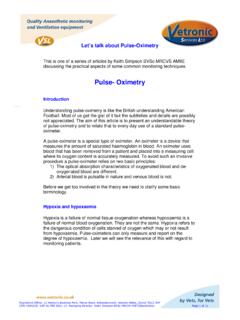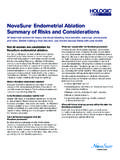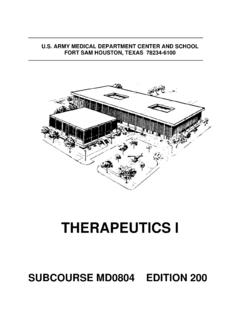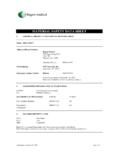Transcription of Selecting An Anesthetic Circuit - Vetronic
1 Selecting An Anaesthetic CircuitKeith Simpson BVSc MRCVS MIET(Electronics)Background Graduated University of Bristol 1986 In Mixed/Small animal practice for 15 years Started Vetronic Services in 1992 Professional qualifications in Veterinary medicine and Electronics Interests in anaesthesia, ventilation and patient Say you have a 12kg moribund monkey to anaesthetise. Which Circuit would be best ?Understanding Anaesthetic Circuits Emphasis on understanding, so ask questions if there are any points you are unsure of By understanding anaesthetic circuits you will be able to predict behaviour and understand how best to use them Hope to cover most of this by demonstration as well as slidesOther considerations Anaesthetic is often in make-shift surroundings with less than ideal facilities Patient survival and fitness should override normal cost objections as long as they are reasonable Patients are often more depressed than they appear and often have had alpha-2 or other respiratory depressant drugs prior to gaseous anaestheticOnly 3 to breathe to breathe rebreathing of Carbon DioxideSo,all we need is a means of delivering fresh gas and a means of removing expired gasFundamental facts Expired gas has 2 portions Anatomical Dead Space Gas Alveolar gas Anatomical Dead Space Gas is unchanged and can be re-used.
2 Build-A- Circuit A bit like Start with a single tube feed Fulfils the requirements for 1+2 but not for 3 Clearly won t work, so we need a separate tube to enable exhalation. This is better, but can see that both tubes are being used. Also, ideally we need a way of introducing anaesthetic agent & oxygen. Feed a supply of fresh gas into one pipeBuild-A- Circuit See how expiratory pipe is only used for expiration if FGF is sufficient to meet demand If demand isn t met then some gas is pulled back from the expiratory pipe. This is fine because it is full of fresh gas as long as FGF is high enoughBuild-A- Circuit What s happening here in terms of capnography? Let s use a mainstream capnograph to see what exactly is going Looks fairly good as long as we breathe Why? 10L/min is 170mls/second. Tube volume is 570mlsBuild-A- Circuit What have we created? A T-piece Circuit Of all the circuits this is the safest, simplest and easiest to breathe through. There is very little breathing resistance.
3 Circuit It becomes more wasteful of gas the larger the patient becomes:FGF = x Minute Volume Minute Volume = TV x RR 75kg animal needs a FGF of around 18L/min (10mls/kg, 10 BPM, CF= )So a 680L E-cylinder is only going to last half an hour (and use a lot of volatile agent)T-Piece Circuit The bag is unusual in that the gas passes straight through it. What s the bag for? Partly for rebreathing (it is flat most of the time) but mainly to allow IPPV. Don t actually need the bag. A length of tubing will do needs to be at least 50% of TVBuild-A- Circuit To improve efficiency we want our FGF to get closer to our MV requirement. At the beginning of each exhalation the breath contains no CO2 and is the same composition as the fresh gas. If we could capture that then it would be a major saving So, let s put a bag on the Expiratory port and see what happens But this time the bag will be a closed bag and used to hold gas off to the side of the circuitBuild-A- Circuit It behaves a bit like a T-piece but now we are re-using more of the gas, which is better.
4 It looks really good because gas is being reused, but how good is it? It s really quite bad, even at high flow rates The problem is that it encourages rebreathing of alveolar gas. We only want to re-breathe the Dead Space Gas. This is the first portion of gas exhaled. So if we put a valve on our expiratory Circuit and keep our bag full we can recycle only the Dead Space Gas and not the alveolar gas How is it now?Build-A- Circuit What have we created? A Bain Circuit (Actually a Modified Bain)Build-A- Circuit Not as efficient as a Lack (Later). The Circuit factor is Much safer and more efficient at IPPV This may be a consideration if you anticipate needing IPPV during your procedure We will come back to the subject of IPPV laterBuild-A- Circuit What if we put the bag in the inspiratory limb? Would that be better or worse? Let s start with just a bag and a normal Fresh Gas FlowBuild-A- Circuit It kind of works but most of the gas is going out of the expiratory limb Can easily stop that by putting a valve at the end of the expiratory limb.
5 The valve won t open until there is at least 1cm pressure so now our breath goes preferentially into the bag until that is full. Now it looks far more efficientBuild-A- Circuit What have we created? A Lack Circuit (or a type of Magill)Build-A- Circuit What does the capnograph tell us? The Circuit seems to be working well As long as the bag is full at the start of inspiration it works really well If the bag isn t full at the start of inspiration it is just like breathing in and out of a paper bag!The Lack Circuit So much more efficient than a T-piece, Lack Circuit The presence of the valve may cause problems for our smaller patients Our larger patients may experience more Circuit resistance because of the higher flows and the presence of a valve If the bag is not full at the start of inspiration then rebreathing of CO2 may occurThe Lack Circuit How does it work? System is full of fresh gas and so bag is full Patient takes a breath, pulling fresh gas from the bag and from the FGF.
6 Cannot pull from the expiratory limb because of the valve Patient breathes out and Dead Space Gas goes into deflated bag. Once bag is full alveolar gas goes out through expiratory limbThe Lack Circuit How big does the bag need to be? What if the bag is too big? What must we keep an eye on whenever we use it?THE BAG!!The Lack CircuitCircuit flow rates: Calculate Minute Volume Apply Circuit factor of (Magill) or for a LackBuild-A- Circuit - Lack For this Circuit to work effectively the bag must be full at the end of expiration and remain full during the expiratory pause while the FGF flushes out the alveolar gas The valve and expiratory tubing increase the work of breathing so this Circuit is not suitable for smaller animalsIPPV - Manual Let s look at how to implement manual IPPV with the different systems Knowing how to implement IPPV with different circuits is important as getting it wrong can cause serious harm to your patientsIPPV with a T-Piece or the end of the reservoir bag (T-piece) or close the valve (Bain) gas to fill the the bag to inflate the bag or open valve and allow patient to with a T-Piece or Bain It is difficult to re-introduce alveolar gas because the flow rates are much higher than with a Lack.
7 The CF is typically to 3 Manual ventilation with a Lack How many of you would routinely close the valve on a Lack Circuit and give 2 or three breaths and then open the valve again?Manual ventilation with a Lack First time you squeeze the bag fresh gas forced in to animal. Manual ventilation with a Lack Then when you release the bag, waste gas preferentially goes back into bagManual ventilation with a Lack Second time you squeeze the bag, you force waste gas back into patient. Very easy to cause rebreathing Cannot be repeated at speed without rebreathingManual ventilation with a Lack After patient has exhaled, close the valve Let bag fill up with fresh gas Squeeze the bag to inflate the chest Maintain the pressure on the bag and open the valve the patient breathes out Close the valve and THEN release pressure on the bag Let the bag fill up with fresh ventilation with a Lack To do this properly takesa) Time; because the bag has to refillb) Care; because the sequence is important Summary of circuits Mapleson A = Magill (or Lack) Very efficient and safe for spontaneously breathing animal CF = (Lack) or (Magill) Mapleson E (T-piece) or D (Bain) Require higher FGF rates than Magill and are therefore less efficient More suited to the smaller animals especially the T-piece CF= - 3 Combining the 3 types of circuits, Mapleson A, D and E The Humphrey ADE is a system designed to allow quick change-over between the 3 different Circuit designs.
8 In one setup (lever UP) the system is a Mapleson A and is very efficient for spontaneously breathing animals In the other setup (lever DOWN) the system is a Mapleson D (with bag) or EThe Humphrey ADE The Humphrey ADE system is designed to improve the efficiency of the Mapleson A,D and E type circuits. It achieves this mainly by the inclusion of a specially designed valve. If there are any problems with this valve then Circuit behaviour will be severely disrupted. The function of this valve MUST be checked regularlyCircle systems It s only the CO2 that we want to get rid of and there s only 4-5% in an exhaled breath, so if we could just remove that then 95% of the breath could be recycled and our Fresh Gas Flow Rate could be much lower How low? Metabolic systems A circle system recycles expired gas by removing the carbon dioxide and preserving the anaesthetic agent There is an inherent resistance to a circle system which limits its usefulness in the smaller animalsCircle systems Basic requirements Supply enough oxygen to support life (must at least match metabolic requirement) Remove waste carbon dioxide Circle systems:Metabolic requirement The metabolic requirement is approximately 10mls/kg/minute.
9 This means that a 30kg labrador needs 300mls/minute of 100% oxygen to supply enough oxygen to maintain all vital functionsCircle systems How does it work? There are now 2 valves in the Circuit to completely control the direction of gas flow. The fresh gas flow rate will now have little or no effect on rebreathing ** We only need to supply metabolic oxygen Prove systems Work of breathing is increased, so consider the patient Is it weak and moribund or fit, well and strong? If it is weak and moribund, consider a Modified Bain rather than the circle (easier to breathe through and good for IPPV)Circle systems:In In practice it takes some time for agents such as Isoflurane to stabilise (Insp=Exp) in the patient, so an initial high flow must be maintained to ensure the patient remains asleep Also minor leaks may mean that achieving a flow as low as 10mls/kg/min is difficultCircle systems Most people run a circle initially at around 2L/min for a 20-30kg animal. There are some good reasons for doing this: Denitrogenation and agent levels change quickly FGF is still much reduced compared to a non-rebreathing system ( which would be 6-9L/min) Consumption of agent is still much reduced compared to a non-rebreathing system Exhaustion of soda lime is reduced compared to running it as a closed systemCircle systems After several minutes once the patient has stabilised the FGF can be reduced substantially.
10 However, most people are fearful of running at very low levels and it does take a certain amount of skill and experience to do this wellCircle systems - IPPV IPPV is easy! Just squeeze the bag, release and cannot go wrongAnaesthetic Circuits Selection decisions In the exotic world I do not think that economy and efficiency are paramount More important is minimising morbidity and mortality. It s not just about surviving the anaesthetic, you want your patients to spring energetically off the table at the end. Selection Decisions Remember that the ease of breathing through these systems is in the order:T-pieceLack/BainCircle Assess your patient to obtain its respiratory rate and body weight, then calculate the Minute Volume requirementSelection DecisionsIf the patient is fit and healthy:If the MV is less than 1L/min then use a T-pieceIf the MV is more than 1L but less than 4L then use a Lack (Mini or Standard) or a modified BainIf the MV is over 4L then consider a circleSelection DecisionsNow consider these modifying factors:Patient is weak or moribund:Use a Circuit which fits the criteria above but look at the Circuit below it on the scale.







